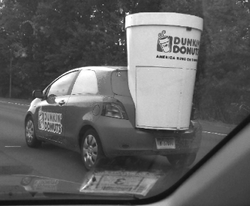
Contributed by: Brian Shoemaker
Part One:
Mr. Shoemaker saw this Dunkin Donuts car driving along I-84 in Connecticut and started wondering if it could be full of coffee.
How much would that much coffee weigh? Wouldn’t the car tip over? Wow, how much would that much coffee cost?
I really like the problem posed, as it helps students to think about whether or not certain scenarios are realistic that they see in the media and in their everyday life. While it is not something that students need to know, I think it is something that many would take an interest in.
Part Two:
Find out if this would even be possible.
- You’ll need to estimate the volume of the cup and then find out the weight of the coffee that would fill it.
- Assume that coffee has the same weight as water.
- You should come up with dimensions of the cup based on its relationship to the car. The car is probably a Mazda 2. You can get all of the vehicle information online.
- You’ll need to find the cargo limit for the car.
I think my students’ initial reaction to this problem will be one of surprise. They are not accustomed to doing research for a math problem, and I think they will worry about whether or not they are using the “correct” website or the "correct" information. I will need to emphasize that two groups can have a correct solution, even if their answers are not exactly the same. The importance will be in documenting their sources.
In this set up instructions, I would probably move bullet point #3 to the beginning. This will allow students to figure out the volume of the cup and the weight of the coffee for the life-size cup, rather than have to perform yet another conversion later on.
Another way that I would need to support my students is to help them calculate the measurements of the cup based on the specs of the Mazda 2 and the picture provided. If measurements were labeled on the picture, I don’t think students would have a problem. In their usual math problems, they are so used to being provided with all the measurements necessary for their calculations. Again I would have to assure them that a minute measurement error will not cause them to get the problem wrong.
I am a little concerned with the implication of the last bullet point. By finding the cargo limit of the car, does not not necessarily answer the question of whether or not the car would tip over. The weight could be under the cargo limit, but the imbalance of that weight on the back of the car could be enough to tip it. To address this, I would do one of two things: 1) I would rephrase the question in the introduction from “Wouldn’t the car tip over?” to “Is the weight of the coffee under the cargo limit?” or 2) Add a question asking students to decide if a weight under the cargo limit is sufficient to conclude that the car would not tip over.
Part Three:
Present your guess. You must clearly show how you found the volume of the cup, the conversion to either kg or pounds, and then your guess about if the car could carry it. You should draw on your own diagram showing how you came up with your measurements.
I think the most crucial way for me to set my students up to be successful would be to model for them what a solution or partial solution would look like, even if for another problem. They need to understand that just because it makes sense to them, does not mean it will make sense to their reader (or grader!).
Part Four:
If it is possible, how much would the coffee cost? You’ll need to explain this also. Is the cost of coffee proportional to the amount that you buy?
I’m not sure I understand what this last question is asking (if the cost of coffee is proportional to the amount that that you buy). My best interpretation is that this is referring to costs of a small, medium, and large coffee. This would be a great question, as students will likely discover that buying a bigger size is often a better deal. I just think this needs to be worded a little more explicitly.
Overall, I am very excited about using this in my class. I love that it pulls together multiple concepts (volume, unit conversions, proportions/ratios, etc), just as SBAC assessment items promise to do. It also has shown me that writing my own performance tasks in the future would be a very doable thing. Thanks to Mr. Shoemaker for sharing!
 RSS Feed
RSS Feed